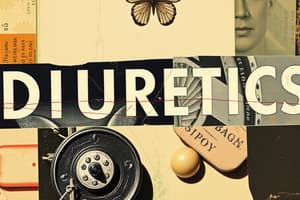Podcast
Questions and Answers
Which of the following medications works by reducing glucose reabsorption in the kidneys?
Which of the following medications works by reducing glucose reabsorption in the kidneys?
- Dapagliflozin (correct)
- Spironolactone
- Frusemide
- Erythropoietin
A patient with chronic renal failure is experiencing anemia. Which of the following would be most suitable to address this specific issue?
A patient with chronic renal failure is experiencing anemia. Which of the following would be most suitable to address this specific issue?
- Potassium
- Erythropoietin (correct)
- Hydrochlorothiazide
- Albumin
Which type of intravenous solution is most appropriate for a patient experiencing cellular dehydration?
Which type of intravenous solution is most appropriate for a patient experiencing cellular dehydration?
- 5% Dextrose
- 0.9% Normal Saline
- 10% Dextrose (correct)
- 4.5% N/S
A patient is prescribed a medication that blocks sodium reabsorption in the loop of Henle. Which diuretic is most likely being used?
A patient is prescribed a medication that blocks sodium reabsorption in the loop of Henle. Which diuretic is most likely being used?
Which of the following best describes the mechanism of action of albumin when administered intravenously?
Which of the following best describes the mechanism of action of albumin when administered intravenously?
Which medication is a dopamine precursor utilized in the treatment of Parkinson's disease?
Which medication is a dopamine precursor utilized in the treatment of Parkinson's disease?
A patient with a suspected opioid overdose has been administered naloxone. Which response would be expected given the mechanism of action of this medication?
A patient with a suspected opioid overdose has been administered naloxone. Which response would be expected given the mechanism of action of this medication?
What is a common mechanism of action of phenytoin, carbamazepine, and lamotrigine?
What is a common mechanism of action of phenytoin, carbamazepine, and lamotrigine?
Which of the following best describes the primary action of lactulose?
Which of the following best describes the primary action of lactulose?
A patient with type 2 diabetes is prescribed metformin. What is the primary mechanism by which this medication helps to manage blood glucose levels?
A patient with type 2 diabetes is prescribed metformin. What is the primary mechanism by which this medication helps to manage blood glucose levels?
A patient is experiencing seizures and is prescribed Midazolam. What is the primary action of this medication that makes it effective for this purpose?
A patient is experiencing seizures and is prescribed Midazolam. What is the primary action of this medication that makes it effective for this purpose?
Which combination of medications directly reduces the production of gastric acid?
Which combination of medications directly reduces the production of gastric acid?
What is a potential adverse effect of mannitol that needs to be carefully monitored?
What is a potential adverse effect of mannitol that needs to be carefully monitored?
Flashcards
What is a SGLT2 inhibitor like Dapagliflozin used for?
What is a SGLT2 inhibitor like Dapagliflozin used for?
A medication that helps lower blood sugar by preventing the kidneys from reabsorbing glucose back into the bloodstream.
What is a loop diuretic like Frusemide known for?
What is a loop diuretic like Frusemide known for?
A type of diuretic that works in the loop of Henle, preventing sodium reabsorption and increasing urine production.
What does Erythropoietin do?
What does Erythropoietin do?
A hormone produced by the kidneys that stimulates the production of red blood cells.
What is Mannitol?
What is Mannitol?
Signup and view all the flashcards
What are Crystalloid solutions like NS 0.9% and CSL used for?
What are Crystalloid solutions like NS 0.9% and CSL used for?
Signup and view all the flashcards
What is Naloxone?
What is Naloxone?
Signup and view all the flashcards
What happens when Hypotonic solutions like 10% Dextrose are administered?
What happens when Hypotonic solutions like 10% Dextrose are administered?
Signup and view all the flashcards
What are Anti-Seizure Medications?
What are Anti-Seizure Medications?
Signup and view all the flashcards
What is Levodopa?
What is Levodopa?
Signup and view all the flashcards
What is Midazolam?
What is Midazolam?
Signup and view all the flashcards
What are Histamine 2 Blockers?
What are Histamine 2 Blockers?
Signup and view all the flashcards
What is Loperamide?
What is Loperamide?
Signup and view all the flashcards
What are Proton Pump Inhibitors?
What are Proton Pump Inhibitors?
Signup and view all the flashcards
Study Notes
Diuretics
- Mechanism (Mannitol): Alters osmosis, reducing water volume and intracranial pressure (ICP).
- Indications (Mannitol): Cerebral edema, increased ocular pressure.
- Adverse Effects (Mannitol): Risk of fluid leaking back into interstitial spaces, potentially worsening cerebral edema.
- Mechanism (Loop Diuretic - Frusemide): Blocks sodium reabsorption in the loop of Henle.
- Mechanism (Thiazide - Hydrochlorothiazide): Acts in the distal tubule, depleting potassium.
- Mechanism (Potassium-Sparing - Spironolactone): Counteracts potassium loss.
- Indications (Diuretics): Hypertension, chronic renal failure.
Opioid Antagonist
- Mechanism (Naloxone): Blocks opioid effects at mu opioid receptors, preventing G protein coupling.
- Indications (Naloxone): Opioid overdose.
- Other Considerations (Naloxone): Quick onset, short-acting; requires repeated dosing.
Anti-Seizure Medications
- Sodium Valproate (Epilim): Increases GABA, blocks sodium channels. Used for seizures, epilepsy, and mania.
- Phenobarbital (Barbital): Enhances GABA action, reduces seizure spread. Indicated for epilepsy and sedation.
- Phenytoin (Dilantin): Modulates sodium channels, stabilizing nerve excitability. Used in tonic-clonic seizures and post-surgery.
- Carbamazepine: Reduces nerve impulses, treating seizures, nerve pain, schizophrenia, and bipolar disorder.
- Gabapentin: Blocks nerve signals, treats seizures and nerve pain. Risk of dependence and suicidal thoughts.
- Lamotrigine: Modulates sodium channels, reduces glutamate release. Treats seizures, nerve pain, and bipolar disorder.
Dopamine Precursor and Decarboxylase Inhibitor
- Levodopa (Sinemet): Converts to dopamine in the brain, used for Parkinson's disease.
- Carbidopa: Inhibits peripheral conversion of levodopa.
Sedative
- Mechanism (Midazolam): Acts on GABA A receptors, calming the brain.
- Indications (Midazolam): Seizures, anesthesia.
Gastrointestinal (GIT) Medications
- Histamine 2 Blockers (Ranitidine, Famotidine): H2 receptor antagonists inhibit gastric acid production.
- Indications (Histamine 2 Blockers): Gastric ulcers, heartburn, GERD.
- Anti-Diarrheal (Loperamide): Activates opioid receptors in the gut, reducing stool frequency.
- Indications (Anti-Diarrheal): Diarrhea.
- Proton Pump Inhibitors (Pantoprazole): Suppresses gastric acid secretion.
- Indications (Proton Pump Inhibitors): GI lesions, ulcers, GERD.
- Laxative (Lactulose): Prevents ammonia absorption, softens stools.
- Indications (Lactulose): Hepatic encephalopathy, stool softening.
Endocrine Medications
- Insulin (Short-Acting): Actrapid, Novorapid
- Insulin (Long-Acting): Solostar, Optisulin
- Mechanism (Insulin): Regulates glucose metabolism, lowers blood glucose levels (BGL).
- Indications (Insulin): Type 1 and Type 2 diabetes mellitus (T1DM, T2DM).
- Biguanide (Metformin): Reduces liver glucose production, increases insulin sensitivity.
- Indications (Biguanide): First-line treatment for T2DM.
- Sulfonylureas (Glipizide): Increases insulin secretion.
- Indications (Sulfonylureas): Adjunct for T2DM.
- SGLT2 Inhibitor (Dapagliflozin): Reduces glucose reabsorption in kidneys.
- Indications (SGLT2 Inhibitor): T2DM, weight loss, fluid management.
Renal Medications
- Hormone (Erythropoietin): Stimulates RBC production.
- Indications (Erythropoietin): Anemia in chronic renal failure or cancer.
- Vitamin D: Increases calcium and phosphate absorption.
- Indications (Vitamin D): Vitamin D and calcium deficiency.
- Colloid (Albumin): Increases osmotic pressure, retains fluid intravascularly.
- Indications (Colloid): Fluid resuscitation, shock, rehydration.
Electrolytes and Fluids
- Electrolyte (Potassium): Maintains muscle and nerve function.
- Indications (Potassium): Potassium deficiency.
- Crystalloid Solutions (NS 0.9%, CSL, Dex5%): Match osmolarity of blood, no fluid shifts.
- Indications (Crystalloid Solutions): Fluid resuscitation, shock.
- Hypotonic Solutions (10% Dextrose, 50% Dextrose): Move water into cells.
- Indications (Hypotonic Solutions): Hyponatremia, cellular dehydration.
- Hypertonic Solutions (0.45% N/S): Move water out of cells.
- Indications (Hypertonic Solutions): Hypernatremia, reduce intracranial pressure.
Studying That Suits You
Use AI to generate personalized quizzes and flashcards to suit your learning preferences.




